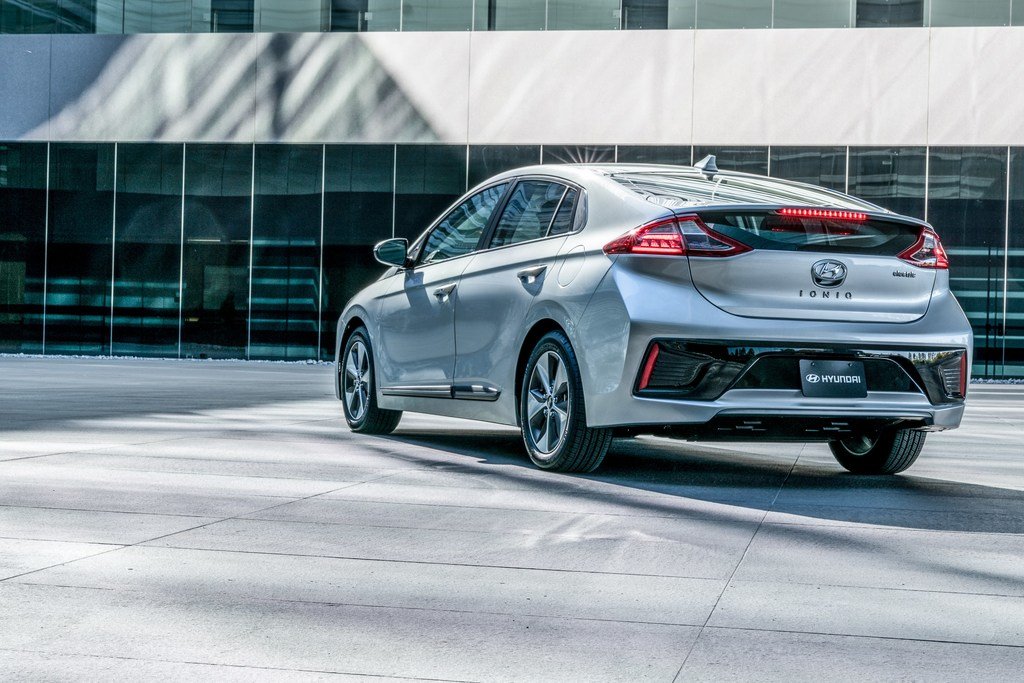The eco-friendly Hyundai Ioniq has three different electrified powertrains on a single, dedicated platform Hyundai says offers the latest safety and convenience technologies. The model range has been simplified to include only two trims, Electric and Limited, while a Plug-in Hybrid model joins the lineup. Overall, the Ioniq offers buyers an efficient mode of transportation at a fairly modest price point.
Power & Performance
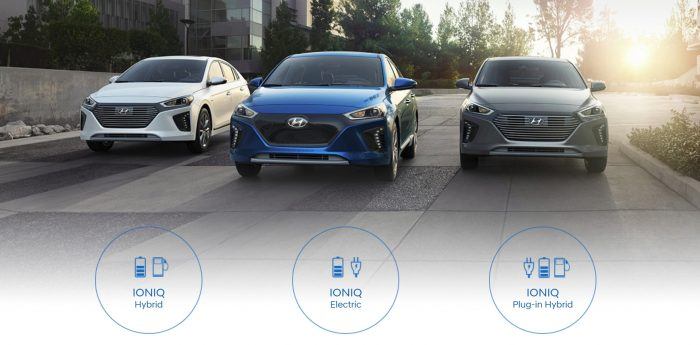
Ioniq Plug-In Hybrid
The 2018 Ioniq Plug-in Hybrid provides an all-electric range of more than 29 miles, 119 MPGe in EV mode, and 52 mpg in hybrid mode. Hyundai utilizes a Kappa 1.6-liter direct-injected Atkinson-cycle four-cylinder engine with improved thermal efficiency. It’s paired to a six-speed double-clutch transmission and a 45kW (60 horsepower) electric motor. The electric motor can function up to 75 mph, with instantaneous torque at low speeds and available power-assist at higher speeds.
Ioniq Hybrid
The Ioniq Hybrid’s 32 kW electric motor creates 43 horsepower and an estimated maximum torque of 125 lb-ft.; the lithium-ion polymer battery has a 1.56 kWh capacity. Total system output is 139 horsepower with an EPA-estimated 58 combined mpg, the highest rating of any non-plug-in vehicle in the United States, according to Hyundai.
Ioniq Electric
Customers can opt for the Ioniq Electric, a completely electric vehicle with a 28 kWh lithium-ion polymer battery and an estimated range of 124 miles. The 88 kW electric motor, paired to a single-speed, reduction-gear transmission, has a maximum output of 118 horsepower and 218 lb-ft. of torque. According to Hyundai, the Ioniq Electric’s EPA-estimated 136 MPGe rating is the highest of any electric vehicle in the United States.
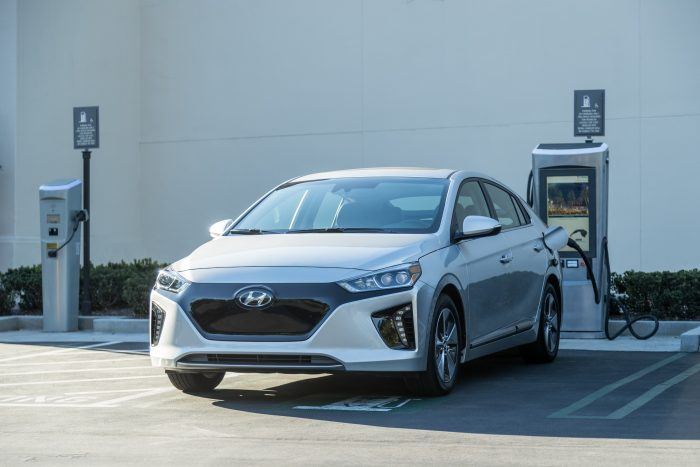
Battery Composition
One of the central components of the Ioniq is the battery, designed to be compact, lightweight, and highly efficient. Battery power for each Ioniq model comes from something called a permanent magnet synchronous motor. Hyundai says the parts were “optimized by reducing the thickness of core components by up to 10 percent and adopting rectangular-section copper wire to decrease core and copper loss.”
The lithium-ion polymer battery pack is 20 percent lighter than non-polymer lithium-ion batteries, something Hyundai believes is key for efficiency and interior room. With the battery’s placement (under the rear seats) and the vehicle’s center of gravity taken into account, the Ioniq Hybrid provides over 120 cubic feet of total interior volume. The Ioniq Plug-in Hybrid and the Ioniq Electric, despite having larger battery systems, still offer nearly 120 cubic feet of interior volume. The Ioniq Electric has Level 3 DC fast-charging capability.
Transmission Tech
The Ioniq Plug-in Hybrid and Hybrid both feature the aforementioned six-speed EcoShift dual-clutch transmission. Low-friction bearings and low-viscosity oil are hallmarks of the transmission, designed to be more fun to drive. Hyundai notes the criticisms of Continuously Variable Transmissions, saying the “rubber band-like acceleration” synonymous with the typical hybrid is not a characteristic of the Ioniq. Drivers can even select a Sport mode which holds the lower gears for longer, and combines engine and electric motor power for more spirited driving.
Light & Tight
Hyundai’s engineers pursued significant weight reduction targets to increase efficiency and performance. Aluminum was utilized for the hood and tailgate, which dropped 27 lbs. from the Ioniq. The lead-acid auxiliary 12V battery found in other hybrids was cut from the Ioniq Hybrid, a savings of 26 lbs. Less obvious components, like the cargo screen cover, saw a weight reduction.
The Ioniq Plug-in Hybrid and Hybrid use a multi-link rear suspension, complete with dual lower control arms to enhance ride and handling. Aluminum usage throughout the suspension saves about 22 lbs. – roughly 13 lbs. in the front and another nine in the rear. The Ioniq Electric utilizes a torsion-beam rear axle, providing more space for the 28 kWh lithium-ion polymer batteries. The steering and regenerative braking systems received additional tweaks while Michelin low-rolling-resistance tires were added. Overall, Hyundai says the focus was to create a responsive and engaging vehicle.
Structurally, the Ioniq is more than 50 percent advanced high-strength steel to provide the torsional rigidity necessary for both performance and safety. Over 470 feet worth of advanced structural adhesives are employed to increase rigidity and facilitate weight reduction.
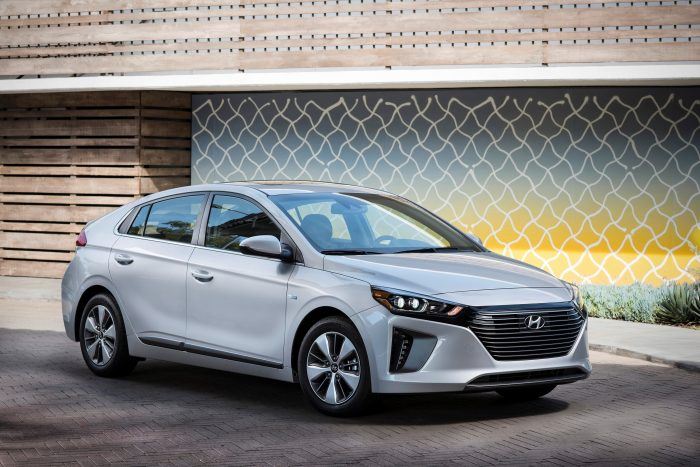
Aerodynamic Art
Similar to the weight reduction measures, specific aerodynamic targets were set. Throughout development, engineers and designers worked closely to ensure a stylish and functional design. Applications like front wheel air curtains, a rear spoiler and diffuser, side sill moldings, and a closed-wheel design contribute to a high aerodynamic efficiency of 0.24 Cd. Further, the Plug-in Hybrid and Hybrid feature a three-stage active air flap integrated with the front grille.
Hyundai says form and function evolved simultaneously in a complementary fashion, something Ioniq buyers will likely appreciate.
Eco Interior
Recycled and other ecologically-sensitive materials are found inside the Ioniq, one of the car’s most interesting but little known facts. The interior door covers are made of plastic combined with powdered wood and volcanic stone, and there are less oil-based products inside overall. Raw materials extracted from sugar cane were applied on the headliner and carpet, for example. Renewable ingredients extracted from soybean oil were used for the metallic paint seen on the Ioniq’s various components.
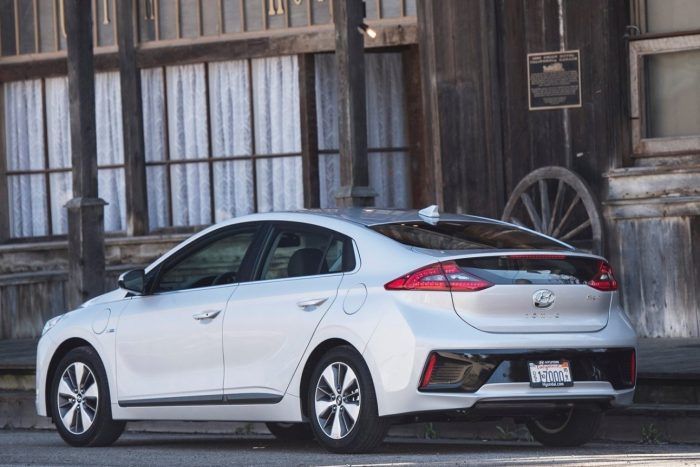
Connectivity & Security
The 2018 Ioniq features Apple CarPlay, Android Auto, and Hyundai’s Blue Link connectivity services. The latter offers Remote Start with Climate Control, Destination Search powered by Google, Remote Door Lock/Unlock, Car Finder, Enhanced Roadside Assistance, and Stolen Vehicle Recovery. Blue Link is also compatible with Amazon Alexa, Android Wear, and Apple Watch.
Advanced safety features include Smart Cruise Control, Automatic Emergency Braking with Pedestrian Detection, Lane Departure Warning with Lane Keep Assist, and Dynamic Bending Lights. There are seven total airbags, including a driver’s knee airbag.
Color Choices
The Ioniq comes in Black Noir Pearl, Symphony Air Silver, Electric Blue Metallic, Ceramic White, Summit Gray, and a new Scarlet Red for the Hybrid model.
Carl Anthony is Managing Editor of Automoblog and resides in Detroit, Michigan.
Photos & Source: Hyundai Motor America.

